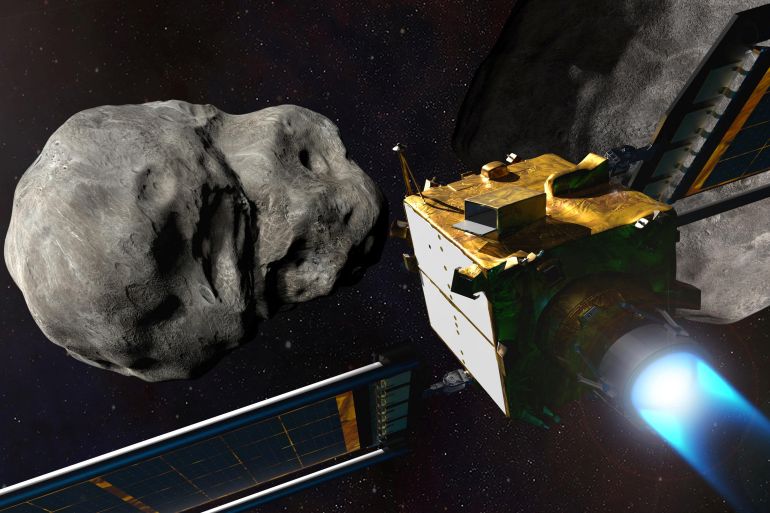NASA says DART spacecraft successfully alters asteroid’s path
Taking a page out of science fiction and Hollywood scripts, US space agency aims to prevent collision with Earth.

NASA says it has succeeded in deflecting an asteroid in a historic test of humanity’s ability to stop an incoming cosmic object from devastating life on Earth.
The fridge-sized Double Asteroid Redirection Test (DART) impactor deliberately smashed into the asteroid Dimorphos on September 26, pushing it into a smaller, faster orbit around its big brother Didymos, NASA chief Bill Nelson said.
Keep reading
list of 3 items‘Planetary defence’: NASA targets asteroid in space collision
Artemis 1 mission: NASA rocket set for second Moon attempt
“DART shortened the 11 hour, 55 minute orbit to 11 hours and 23 minutes,” he said. Speeding up Dimorphos’ orbital period by 32 minutes exceeded NASA’s own expectation of 10 minutes.
“We showed the world that NASA is serious as a defender of this planet,” Nelson said.
The asteroid pair loop together around the sun every 2.1 years and pose no threat to Earth, but they posed an ideal test of the “kinetic impact” method of planetary defence in case an actual approaching object is ever detected.
“There is no risk in this case because this was a deliberately chosen target to make sure that this [asteroid crashing on Earth] would not happen,” Yvette Cendes, an astronomer at Harvard University, told Al Jazeera.
DART’s success as a proof-of-concept has made a reality of science fiction.
Astronomers rejoiced in stunning images of matter spreading out thousands of kilometres in the wake of the impact. The pictures were collected by Earth and space telescopes as well as a satellite that had travelled to the zone with DART.
“I grew up watching Armageddon and Deep Impact and all that, and it is amazing to see this stuff become a reality,” Cendes said.
Thanks to its temporary new tail, Dimorphos, which is 160 metres (530-foot) in diameter or roughly the size of a big Egyptian pyramid, has turned into a man-made comet.
But quantifying just how well the test worked required an analysis of light patterns from ground telescopes, which took a few weeks to become apparent.
The binary asteroid system, which was about 11m km (6.8m miles) from Earth at impact, is visible only as a single dot from the ground.
‘Rubbish pile’
Ahead of the test, NASA scientists said the results of the experiment would reveal whether the asteroid is a solid rock, or more like a “rubbish pile” of boulders bound by mutual gravity.
If an asteroid is more solid, the momentum imparted by a spaceship will be limited. But if it is “fluffy” and significant mass is pushed at high velocity in the opposite direction to impact, there will be an additional boost.
Never actually photographed before, Dimorphos appeared as a speck of light about an hour before impact.
Its egg-like shape and craggy, boulder-dotted surface finally came into clear view in the last few moments as DART raced towards it at roughly 23,500km/h (14,500 mph).
Very few of the billions of asteroids and comets in our solar system are considered potentially hazardous to our planet, and none is expected to hit in the next 100 years or so. But wait long enough, and it will happen.
The geological record shows, for example, that a 9.6km (6 mile) wide asteroid struck Earth 66m years ago, plunging the world into a long winter that led to the mass extinction of the dinosaurs along with 75 percent of all species.
An asteroid the size of Dimorphos, by contrast, would only cause a regional impact, such as devastating a city.
Kinetic impact with a spaceship is just one way to defend the planet, albeit the only method possible with current technology.
Should an approaching object be detected early, a spaceship could be sent to fly alongside it for long enough to divert its path by using the ship’s gravitational pull, creating a so-called gravity tractor.
Another option would be launching nuclear explosives to redirect or destroy an asteroid.
NASA believes the best way to deploy such weapons would be at a distance, to impart force without blowing the asteroid to smithereens, which could further imperil Earth.